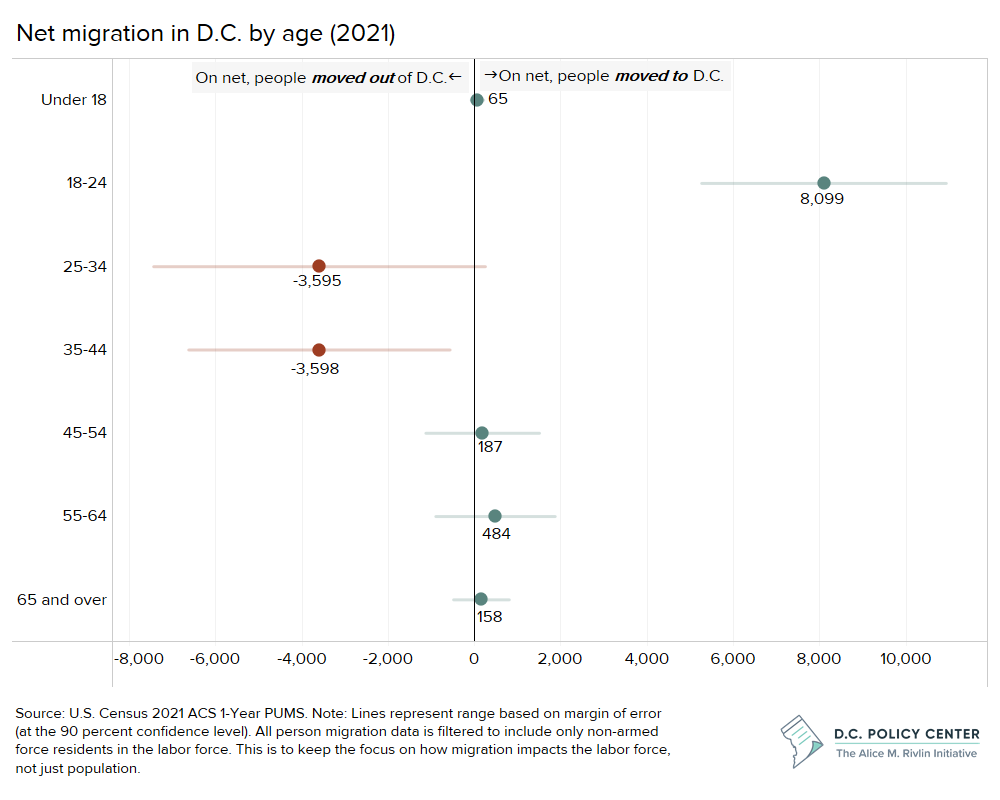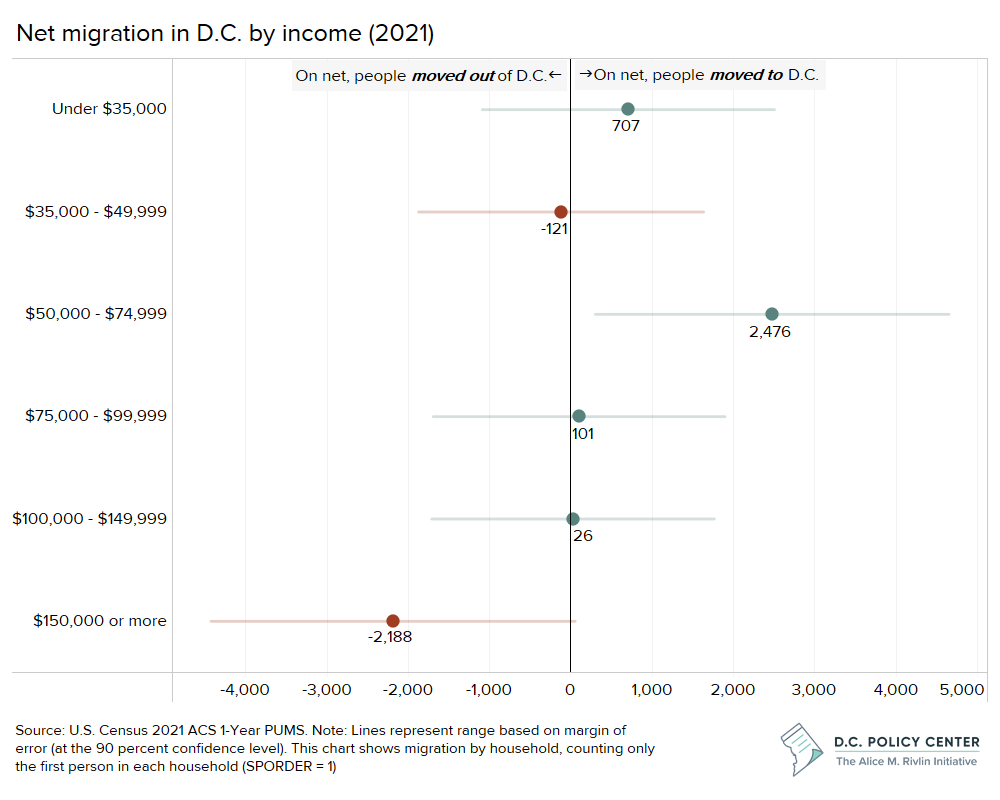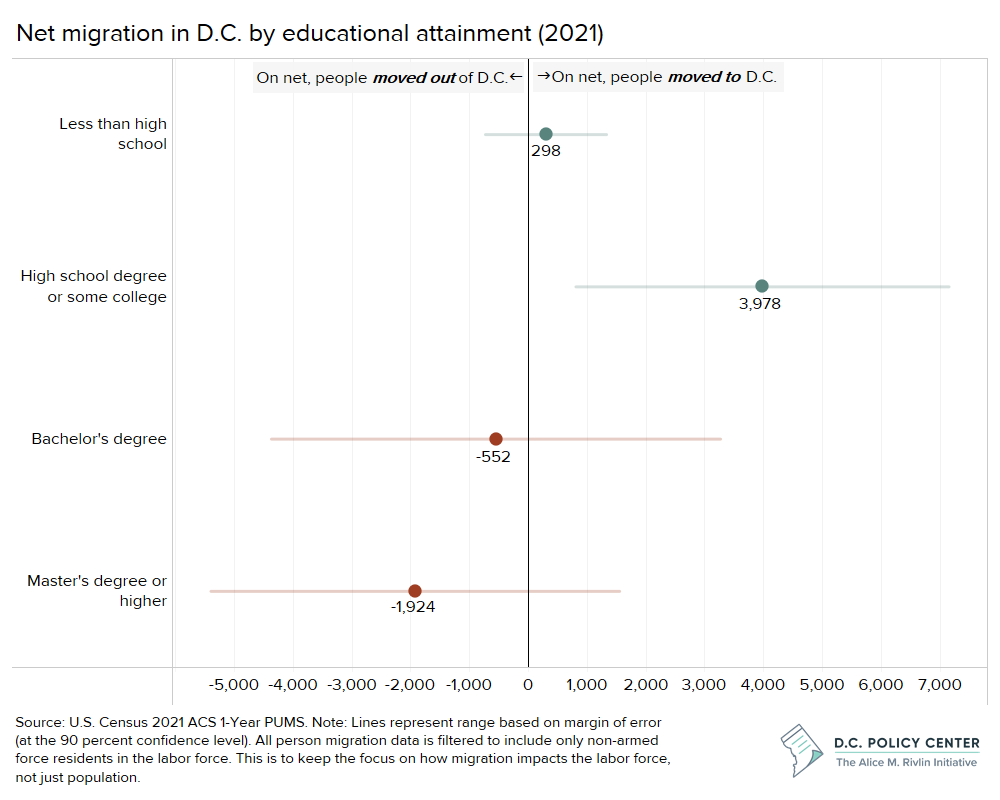Last year, we looked at migration data from 2020 to track demographic shifts in D.C. following the first year of the COVID-19 pandemic. We found the ability to telework was driving some workers out, particularly those well-educated and aged 25 to 34. Recently, 2021 data was released, so we look again at migration across three key demographic groups—age, income, and education—to see if our observations from 2020 held in the second year of the pandemic.
We find that though D.C. likely lost mid-career workers aged 25 to 44, and households earning greater than $150,000 annually, there were some bright spots compared to the first year of the pandemic.
D.C. gained residents aged 18 to 24 and households with annual incomes of $50,000—$74,999 annually, likely stemming from college students re-entering the city and new graduates taking jobs located in D.C. This indicates that D.C. has remained attractive to younger professionals.
The challenge, based on the city’s greatest demographic losses, will be retaining these residents and households as they advance in their careers, start families, and increase their incomes. As people age, they often leave cities in search of larger or more cost-effective housing, for work-related reasons, or to start a family. Though this often pairs with a cycle of incoming young professionals, it would be beneficial for D.C. to be able to retain these residents, so their income growth is not realized elsewhere.
Migration by age
In 2021, D.C. gained a net of 8,0991 residents aged 18 to 24. This captures college students re-entering the city, but could also stem from new graduates, indicating that D.C. is still attractive to younger professionals.2 Despite this success, D.C. struggled to retain those aged 35 to 44. This group includes mid-career professionals that may be looking to move out of the city to start a family, find housing with more space, or access cheaper daycare. Similarly, the city also very likely lost those aged 25 to 35.3

Migration by income
D.C. gained a net of 2,476 households4 earning between $50,000 to $74,999 annually. These households could include early or mid-career professionals with high income growth potential, so retaining these residents is important to the city’s income tax base. Meanwhile, the city saw the greatest decline in households earning greater than $150,000 annually, likely linked to mid-career professionals leaving the city (an assumption based on the loss of those aged 35 to 44). The Internal Revenue Service also publishes migration data, and when released, we will revisit migration trends across different income groups with a bit more granularity.

Migration by education
D.C. also gained residents with a high school degree or some college. Though it is likely that the city lost residents with a Bachelor’s degree or higher, the margin of error at the 90 percent confidence level indicates that it is also possible that the District gained residents in these groups.

Data notes
The source for all migration data is the U.S. Census ACS 1-Year Public Use Microdata Sample (PUMS).
Net migration equals those that moved to D.C. minus those that moved out of D.C.
All person-level migration data (migration by age and educational attainment) is filtered to include only non-armed force residents in the labor force. This is to keep the focus on how migration impacts the labor force, not just population.
All household-level migration data (migration by income) is filtered to include only the first person in each household (variable SPORDER = 1) to avoid double counting.
The margin of errors are calculated at the 90 percent confidence level and according to Census guidelines.
Endnotes
- Margin of error: +- 2,836
- The data is filtered to only include those in the labor force, so this would only capture part-time college students or students with part-time jobs.
- According to the data, on net, D.C. lost 3,595 residents aged 25 to 34 in 2021. But, the margin of error (+-3,598) is high enough that it is also possible that D.C. gained 214 residents in this group (at the 90 percent confidence level).
- Margin of error: +-2,175
